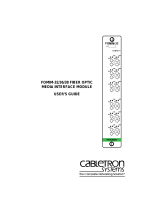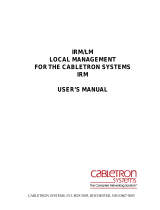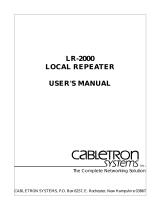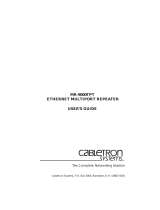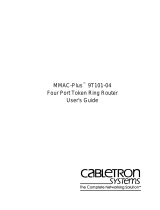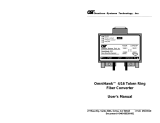Page is loading ...

IRM3
INTELLIGENT REPEATER
MODULE
USER’S GUIDE
A
U
I
T
X
R
X
ON LNK
ETHERNET
IRM3
SN
PWRON
PWR BOK
MGMT
RCV
POK
CLN
RESET
U
P
S
C
O
N
S
O
L
E
F
O
I
R
L

IRM3 QUICK REFERENCE CARD
IRM3 User’s Guide Part of 9030494 -01
LED INDICATORS
LED Description
PWR IRM3 is receiving power from MMAC.
BOK LED lit-Board is operating properly.
LED not lit-Initialization problem. Press
Reset switch.
RCV IRM3 is repeating packet received from a
connected segment.
MGMT IRM3 is receiving/transmitting management
packets.
CLN Collision detected on a segment.
POK Internal repeater port is OK.
ON (AUI) AUI port is active repeater port.
PWR (AUI) AUI port is receiving power.
ON (FO) Fiber Optic port is active repeater port.
LNK (FO) Link is established between port and Fiber
Optic device.
CONNECTIONS
AUI Port: 15-pin D type receptacle
Pin Signal Pin Signal Pin Signal
1 Logic Ref 6 Power Return 11 Logic Ref
2 Collision+ 7 No Connection 12 Receive-
3 Transmit+ 8 Logic Ref 13 Power (+12Vdc)
4 Logic Ref 9 Collision- 14 Logic Ref
5 Receive+ 10 Transmit- 15 No Connection
Console/Modem Port: Standard 9-pin RS232 port
Pin Signal Pin Signal
1 Carrier Detect (CD) 6 Receive Clock (RXCL)
2 Transmit (TXD) 7 Request to Send (RTS)
3 Receive (RXD) 8 Clear to Send (CTS)
4 Data Terminal Ready (DTR) 9 Ring Indicator (RI)
5 Logic Ref
IRM3
SN
RESET
PWR BOK
MGMT RCV
CLN POK
A
ON PWR
ON LNK
T
X
F
O
U
I

IRM3 QUICK REFERENCE CARD
Part of 9030494-01 IRM3 User’s Guide
JUMPER SETTINGS
Jumper Function Setting Default
H1 Enables/Disables Battery.
When enabled, user-entered
parameters are saved if power
to the IRM3 fails. When
disabled, parameters are lost.
Enable: Jumper over pins
1 and 2
Disable: Jumper over pins
2 and 3
Disable
JP1 Makes IRM3 compatible with
any THN-MIMs being used in
the MMAC. This jumper is set
for THN-MIMs with part
numbers 9000043-06 and
above and for THN-MIMs with
part numbers below
9000043-06.
9000043-06 and up:
Jumper over pins 2 and 3
Below 9000043-06:
Jumper over pins 1 and 2
If using both, set over 1
and 2
Jumper
over pins 2
and 3
H6
and H8
Sets IRM3 console and modem
ports for either internal (signal
generated by IRM3) or external
(signal generated by attached
device) Request to Send (RTS)
and Clear to Send (CTS)
signals.
Internal: Jumper over pins
1 and 2
External: Jumper over
pins 2 and 3
External
H1
JP1
H2
H3
H4
H5
H8
H6
Battery
Enable/Disable
THN-MIM Jumper
CTS-Modem Port
CTS-Console Port
For Cabletron Use Only
0494104
1 2 3
1
2
3
H1/JP1
Pin Numbers
H6/H8
Pin Numbers

IRM3 User’s Guide i
NOTICE
Cabletron Systems reserves the right to make changes in specifications and other information
contained in this document without prior notice. The reader should in all cases consult Cabletron
Systems to determine whether any such changes have been made.
The hardware, firmware, or software described in this manual is subject to change without notice.
IN NO EVENT SHALL CABLETRON SYSTEMS BE LIABLE FOR ANY INCIDENTAL,
INDIRECT, SPECIAL, OR CONSEQUENTIAL DAMAGES WHATSOEVER (INCLUDING BUT
NOT LIMITED TO LOST PROFITS) ARISING OUT OF OR RELATED TO THIS MANUAL OR
THE INFORMATION CONTAINED IN IT, EVEN IF CABLETRON SYSTEMS HAS BEEN
ADVISED OF, KNOWN, OR SHOULD HAVE KNOWN, THE POSSIBILITY OF SUCH
DAMAGES.
Copyright 1996 by Cabletron Systems, Inc., P.O. Box 5005, Rochester, NH 03866-5005
All Rights Reserved
Printed in the United States of America
Order Number: 9030494-01 January 1996
SPECTRUM
,
LANVIEW
,
MicroMMAC
, and
BRIM
are registered trademarks and
Element
Manager
,
EPIM
,
EPIM-A
,
EPIM-F1
,
EPIM-F2
,
EPIM-F3
,
EPIM-T
,
EPIM-X
,
FOT-F
,
FOT-F3
,
HubSTACK
,
IRM3,
SEH
,
SEHI
, and
TMS-3
are trademarks of Cabletron Systems, Inc.
All other product names mentioned in this manual may be trademarks or registered trademarks of
their respective companies.
Printed on Recycled Paper

Notice
ii IRM3 User’s Guide
FCC NOTICE
This device complies with Part 15 of the FCC rules. Operation is subject to the following two
conditions: (1) this device may not cause harmful interference, and (2) this device must accept any
interference received, including interference that may cause undesired operation.
NOTE:
This equipment has been tested and found to comply with the limits for a Class A digital
device, pursuant to Part 15 of the FCC rules. These limits are designed to provide reasonable
protection against harmful interference when the equipment is operated in a commercial environment.
This equipment uses, generates, and can radiate radio frequency energy and if not installed in
accordance with the operator’s manual, may cause harmful interference to radio communications.
Operation of this equipment in a residential area is likely to cause interference in which case the user
will be required to correct the interference at his own expense.
WARNING:
Changes or modifications made to this device which are not expressly approved by the
party responsible for compliance could void the user’s authority to operate the equipment.
DOC NOTICE
This digital apparatus does not exceed the Class A limits for radio noise emissions from digital
apparatus set out in the Radio Interference Regulations of the Canadian Department of
Communications.
Le présent appareil numérique n’émet pas de bruits radioélectriques dépassant les limites applicables
aux appareils numériques de la class A prescrites dans le Règlement sur le brouillage radioélectrique
édicté par le ministère des Communications du Canada.
VCCI NOTICE
This equipment is in the 1st Class Category (information equipment to be used in commercial and/or
industrial areas) and conforms to the standards set by the Voluntary Control Council for Interference
by Information Technology Equipment (VCCI) aimed at preventing radio interference in commercial
and/or industrial areas.
Consequently, when used in a residential area or in an adjacent area thereto, radio interference may be
caused to radios and TV receivers, etc.
Read the instructions for correct handling.

Notice
IRM3 User’s Guide iii
CABLETRON SYSTEMS, INC. PROGRAM LICENSE AGREEMENT
IMPORTANT:
Before utilizing this product, carefully read this License Agreement.
This document is an agreement between you, the end user, and Cabletron Systems, Inc. (“Cabletron”)
that sets forth your rights and obligations with respect to the Cabletron software program (the
“Program”) contained in this package. The Program may be contained in firmware, chips or other
media. BY UTILIZING THE ENCLOSED PRODUCT, YOU ARE AGREEING TO BECOME
BOUND BY THE TERMS OF THIS AGREEMENT, WHICH INCLUDES THE LICENSE AND
THE LIMITATION OF WARRANTY AND DISCLAIMER OF LIABILITY. IF YOU DO NOT
AGREE TO THE TERMS OF THIS AGREEMENT, PROMPTLY RETURN THE UNUSED
PRODUCT TO THE PLACE OF PURCHASE FOR A FULL REFUND.
CABLETRON SOFTWARE PROGRAM LICENSE
1. LICENSE
. You have the right to use only the one (1) copy of the Program provided in this
package subject to the terms and conditions of this License Agreement.
You may not copy, reproduce or transmit any part of the Program except as permitted by the
Copyright Act of the United States or as authorized in writing by Cabletron.
2. OTHER RESTRICTIONS. You may not reverse engineer, decompile, or disassemble the
Program.
3. APPLICABLE LAW. This License Agreement shall be interpreted and governed under the laws
and in the state and federal courts of New Hampshire. You accept the personal jurisdiction and
venue of the New Hampshire courts.
EXCLUSION OF WARRANTY AND DISCLAIMER OF LIABILITY
1. EXCLUSION OF
WARRANTY. Except as may be specifically provided by Cabletron in
writing, Cabletron makes no warranty, expressed or implied, concerning the Program (including
its documentation and media).
CABLETRON DISCLAIMS ALL WARRANTIES, OTHER THAN THOSE SUPPLIED TO
YOU BY CABLETRON IN WRITING, EITHER EXPRESSED OR IMPLIED, INCLUDING
BUT NOT LIMITED TO IMPLIED WARRANTIES OF MERCHANTABILITY AND
FITNESS FOR A PARTICULAR PURPOSE, WITH RESPECT TO THE PROGRAM, THE
ACCOMPANYING WRITTEN MATERIALS, AND ANY ACCOMPANYING HARDWARE.
2. NO LIABILITY FOR CONSEQUENTIAL DAMAGES. IN NO EVENT SHALL
CABLETRON OR ITS SUPPLIERS BE LIABLE FOR ANY DAMAGES WHATSOEVER
(INCLUDING, WITHOUT LIMITATION, DAMAGES FOR LOSS OF BUSINESS,
PROFITS, BUSINESS INTERRUPTION, LOSS OF BUSINESS INFORMATION, SPECIAL,
INCIDENTAL, CONSEQUENTIAL, OR RELIANCE DAMAGES, OR OTHER LOSS)
ARISING OUT OF THE USE OR INABILITY TO USE THIS CABLETRON PRODUCT,
EVEN IF CABLETRON HAS BEEN ADVISED OF THE POSSIBILITY OF SUCH
DAMAGES. BECAUSE SOME STATES DO NOT ALLOW THE EXCLUSION OR
LIMITATION OF LIABILITY FOR CONSEQUENTIAL OR INCIDENTAL DAMAGES, OR
ON THE DURATION OR LIMITATION OF IMPLIED WARRANTIES, IN SOME
INSTANCES THE ABOVE LIMITATIONS AND EXCLUSIONS MAY NOT APPLY TO
YOU.

Notice
iv IRM3 User’s Guide
UNITED STATES GOVERNMENT RESTRICTED RIGHTS
The enclosed product (a) was developed solely at private expense; (b) contains “restricted computer
software” submitted with restricted rights in accordance with Section 52227-19 (a) through (d) of the
Commercial Computer Software - Restricted Rights Clause and its successors, and (c) in all respects
is proprietary data belonging to Cabletron and/or its suppliers.
For Department of Defense units, the product is licensed with “Restricted Rights” as defined in the
DoD Supplement to the Federal Acquisition Regulations, Section 52.227-7013 (c) (1) (ii) and its
successors, and use, duplication, disclosure by the Government is subject to restrictions as set forth in
subparagraph (c) (1) (ii) of the Rights in Technical Data and Computer Software clause at 252.227-
7013. Cabletron Systems, Inc., 35 Industrial Way, Rochester, New Hampshire 03867-0505.

IRM3 User’s Guide v
CONTENTS
CHAPTER 1 INTRODUCTION
1.1 Using This Manual.......................................................................1-1
1.2 The Intelligent Repeater Module (IRM3) .....................................1-2
1.3 IRM3 Front Panel ........................................................................1-4
1.3.1 IRM3 Features................................................................1-5
1.4 Repeater Functionality.................................................................1-5
1.5 Network Management Capabilities..............................................1-6
1.6 Getting Help.................................................................................1-7
1.7 Document Conventions...............................................................1-8
1.8 Related Manuals..........................................................................1-9
CHAPTER 2 NETWORK PLANNING AND CONFIGURATION
2.1 Network Requirements................................................................2-1
2.1.1 802.3 Repeater Requirements........................................2-1
2.1.2 AUI Port Requirements...................................................2-1
2.1.3 Fiber Optic Port Requirements .......................................2-2
2.2 The IRM3 in the Multi Media Access Center...............................2-3
2.2.1 Media Interface Modules ................................................2-4
2.3 Sample Network Configuration....................................................2-5
CHAPTER 3 INSTALLING THE IRM3
3.1 Unpacking the IRM3....................................................................3-1
3.2 Setting the IRM3 Jumpers...........................................................3-2
3.2.1 Setting the Battery Enable/Disable Jumper (H1)............3-2
3.2.2 Setting the CTS External/Internal Jumper (H6, H8)........3-3
3.2.3 Setting the THN-MIM Jumper (JP1)................................3-4
3.3 Installing the IRM3 into an MMAC Chassis.................................3-4
3.4 Pre-installation Test.....................................................................3-7
3.5 Connecting the IRM3 to the Network...........................................3-8
3.5.1 Connecting to the Network Through the AUI Port ..........3-9
3.5.2 Connecting to the Network Through the
Fiber Optic Port3-10
3.6 Installation Checkout.................................................................3-12
3.7 Connecting to the UPS Through the Console Port....................3-13

Contents
vi IRM3 User’s Guide
CHAPTER 4 LOCAL MANAGEMENT
4.1 Accessing Local Management Using a Terminal.........................4-3
4.1.1 Configuring a Local Management Terminal ....................4-3
4.1.2 Terminal Attachment Cable Configuration ......................4-4
4.1.3 Connecting the Terminal and Accessing Local
Management4-5
4.2 Accessing Local Management Using a Modem...........................4-7
4.2.1 Modem Configurations....................................................4-7
4.2.2 Modem Attachment Cable Configuration ........................4-7
4.2.3 Connecting the Modem and Accessing Management.....4-8
4.3 The Password Screen..................................................................4-9
4.4 The Device/Board/Port Counters Screen...................................4-10
4.4.1 Configuring the Device/Board/Port Counters Screen....4-11
4.4.2 Device/Board/Port/Counters Screen Fields...................4-12
4.4.3 Resetting the Device/Board/Port Counters ...................4-13
4.4.4 Using the Enable Board/Disable Board Options ...........4-14
4.4.5 Using the Enable Port/Disable Port Option...................4-14
4.4.6 Available Options from the Device/Board/Port Counters
Screen4-14
4.5 Community Names Screen........................................................4-15
4.5.1 Accessing the Community Names Screen....................4-16
4.5.2 Community Names Screen Fields.................................4-16
4.5.3 Editing the Community Names Screen .........................4-17
4.6 The Setup Screen......................................................................4-18
4.6.1 Accessing the Setup Screen.........................................4-19
4.6.2 Setup Screen Fields......................................................4-19
4.6.3 Setting the Set IP Address Option.................................4-20
4.6.4 Setting the Set Current Date Option..............................4-21
4.6.5 Setting the Set Current Time Option.............................4-21
4.6.6 Setting the Device Lock Option.....................................4-21
4.6.7 Setting the Set Refresh Time Option.............................4-22
4.7 Port Association Screen.............................................................4-22
4.7.1 Accessing the Port Association Option .........................4-22
4.7.2 Port Association Screen Fields .....................................4-23
4.7.3 Changing the Port Association......................................4-24
4.8 The Token Ring Board Status Screen.......................................4-24
4.8.1 Accessing the Token Ring Board Status Screen ..........4-25
4.8.2 Token Ring Board Status Screen Fields.......................4-26
4.8.3 Editing the Token Ring Board Status Screen................4-29

Contents
IRM3 User’s Guide vii
CHAPTER 5 TROUBLESHOOTING
5.1 Using LANVIEW..........................................................................5-1
5.2 Troubleshooting Checklist...........................................................5-4
5.3 Using the Reset Switch ...............................................................5-5
5.4 Before Calling Technical Support................................................5-5
APPENDIX A SPECIFICATIONS
A.1 Repeater Functionality.................................................................A-1
A.2 AUI Port.......................................................................................A-2
A.3 Fiber Optic Interface....................................................................A-2
A.4 Console Port................................................................................A-3
A.5 Microprocessors and Memory.....................................................A-3
A.6 Environmental Requirements......................................................A-3
A.7 Agency Approvals........................................................................A-4
A.8 Service.........................................................................................A-4
A.9 Physical Properties......................................................................A-4
INDEX

IRM3 User’s Guide Page 1-1
CHAPTER 1
INTRODUCTION
Welcome to the Cabletron Systems
Intelligent Repeater Module
(IRM3) User’s Guide
. This manual serves as an installation,
management, and reference guide for the IRM3, and includes a
description of the IRM3 capabilities and special features. The IRM3
provides a high performance IEEE 802.3 repeater with sophisticated
network management capabilities for use in a Cabletron Systems Multi
Media Access Center (MMAC).
1.1 USING THIS MANUAL
Before installing and operating the IRM3, read through this guide to gain
a full understanding of its capabilities.
It is assumed that you have a general working knowledge of Ethernet or
IEEE 802.3 type data communications networks and their physical layer
components.
This guide is organized as follows:
Chapter 1,
Introduction
, describes the capabilities of the IRM3,
including an explanation of the IRM3 repeater functionality and its
management capabilities. This chapter concludes with instructions on
how to get help if needed and a list of related manuals.
Chapter 2,
Network Planning and Configuration
, provides
configuration requirements to consider before installing the IRM3. This
chapter also includes a sample configuration for the IRM3.
Chapter 3,
Installing the IRM3
, contains instructions for installing the
IRM3 into an MMAC. This chapter also includes instructions for
connecting the IRM3 to the network.

Chapter 1:
Introduction
Page 1-2 IRM3 User’s Guide
Chapter 4,
Local Management
, describes Local Management (LM) and
control capabilities for the IRM3. Local Management provides the tools
to manage the IRM3 and its attached segments.
Chapter 5,
Troubleshooting
,
details the LANVIEW LEDs incorporated
into the IRM3, which enable you to quickly diagnose any problems that
may occur with the IRM3. This chapter also includes a troubleshooting
checklist, procedures for using the reset switch and instructions for
calling technical support.
Appendix A,
Specifications
, contains location requirements and
operating specifications for the IRM3.
1.2 THE INTELLIGENT REPEATER MODULE (IRM3)
The Intelligent Repeater Module (IRM3) (Figure 1-1) is the heart of the
Cabletron Systems Multi Media Access Center (MMAC). The IRM3
incorporates a high performance IEEE 802.3 repeater to allow maximum
data paths between devices connected to the MMAC.
The IRM3 is Simple Network Management Protocol (SNMP) compliant,
and can be controlled and monitored by a variety of SNMP Network
Management packages. These include Cabletron Systems SPECTRUM
Element Manager for Windows, Cabletron Systems SPECTRUM, and
third party SNMP network management packages. Additionally, the
IRM3 can be controlled and monitored by IRM3/LM - Local
Management for the IRM3 through a terminal connected locally or
through a Hayes compatible modem.

The Intelligent Repeater Module (IRM3)
IRM3 User’s Guide Page 1-3
.
Figure 1-1 Intelligent Repeater Module (IRM3)
A
U
I
T
X
R
X
ON LNK
ETHERNET
IRM3
SN
PWRON
PWR BOK
MGMT
RCV
POK
CLN
RESET
U
P
S
C
O
N
S
O
L
E
0494101
F
O
I
R
L

Chapter 1:
Introduction
Page 1-4 IRM3 User’s Guide
1.3 IRM3 FRONT PANEL
The IRM3 incorporates two ports that connect to external network
segments:
• One pair of IEEE 802.3 FOIRL fiber optic ports. The fiber optic ST
port accommodates a wide variety of multimode fiber optic cable,
including 50/125
µ
m, 62.5/125
µ
m, and 100/140
µ
m fiber optic cable,
up to 2 km in length.
• An IEEE 802.3 compliant AUI port. The AUI port allows you to
connect the module to a variety of Ethernet transmission media
including twisted pair, fiber optic, and/or thick or thin Ethernet coaxial
cable by way of an external transceiver.
Either one of these ports can act as the repeater port to the external
network. When the IRM3 is first powered up, the AUI port acts as the
repeater port and the fiber ports are off. Using the IRM3 network
management capabilities (see Chapter 4,
Local Management
), you can
reverse this configuration to have the fiber port act as the repeater port and
have the AUI port off. This configuration allows you to connect the IRM3
to a fiber optic link segment directly without having to use an external
fiber optic transceiver.
The IRM3 also provides the option, through remote management, to set
one port as the active repeater port and the other port as a redundant
repeater port.
Built into the front panel of the IRM3 are two standard 9-pin RS232
console ports labeled CONSOLE and UPS. The CONSOLE port enables
you to access the IRM3/LM locally or remotely using a Hayes compatible
modem. If you are using a CS-600R/CS-1250R series Uninterruptible
Power Source (UPS), the UPS port enables you to monitor and control the
UPS through the IRM3 using SPECTRUM Element Manager for
Windows or SPECTRUM. The front panel also has a reset switch to
initialize the IRM3 processor.
The IRM3 incorporates the Cabletron Systems LANVIEW Status
Monitoring and Diagnostic System. If a problem arises, such as a power
failure or a cable fault, the LANVIEW LEDs (see Section 5.1,
Using
LANVIEW
) help you to diagnose it.

Repeater Functionality
IRM3 User’s Guide Page 1-5
The LANVIEW LEDs on the IRM3 indicate the following conditions:
• The IRM3 is receiving power
• An error has been detected with the IRM3
• The IRM3 is receiving packets from any segment connected to the
MMAC
• The IRM3 is detecting a collision from the network
1.3.1 IRM3 Features
There are a number of features that provide for efficient use and
maintenance of the IRM3. These features include the following:
• Flash EPROM. This feature enables you to upgrade the IRM3 without
replacing firmware. Flash EPROMs can be updated remotely by
downloading the new software by way of Cabletron Systems
SPECTRUM Element Manager for Windows.
• Thermal Sensors. These sensors warn the management station if the
IRM3 begins to overheat.
• Ethernet SNMP Proxy. With SNMP proxy, you can use IRM3 remote
management to control power settings for the American Power
Conversion’s uninterruptible power source (UPS).
• Connect the UPS to the IRM3 UPS port to control the power supply
through an SNMP compliant network management tool, such as
Cabletron Systems SPECTRUM Element Manager for Windows and
SPECTRUM.
1.4 REPEATER FUNCTIONALITY
The IEEE 802.3 compliant repeater on the IRM3 provides the MMAC
with the ability to achieve maximum data paths on all Ethernet
transmission media, including 10BASE-T, fiber optic, and thick or thin
Ethernet type cabling. To attain maximum data paths, the IRM3 retimes

Chapter 1:
Introduction
Page 1-6 IRM3 User’s Guide
data packets and regenerates the preamble of each data packet that enters
the MMAC.
In addition, IRM3 repeater functionality assures that problem segments
connected to any port on the MMAC do not affect any other segments
connected to the MMAC. If 32 consecutive collisions are detected on any
segment, or if a collision detector is on for more than 2.4 ms, the IRM3
automatically partitions that segment. The segment automatically
reconnects to the MMAC after a packet is transmitted onto the segment
without causing a collision.
1.5 NETWORK MANAGEMENT CAPABILITIES
The Cabletron Systems IRM3 can be controlled and managed by a variety
of network management packages which include the following:
• Cabletron Systems SPECTRUM
• Cabletron Systems SPECTRUM Element Manager for Windows
• Cabletron Systems IRM3/LM (Local Management)
• Third Party SNMP compliant Network Management Packages
The IRM3 network management capabilities provide the necessary
management tools for the IRM3 to operate at its full capacity. Your ability
to set up parameters within the network management capabilities ensures
optimal performance of the IRM3, and, hence, the network.
For example, a great deal of statistical information on the port, board, and
MMAC device level is gathered by the IRM3, including each of the
following:
• Packets • Bytes Received
• Collisions • Giant Packets
• Runt Packets • Misaligned Packets
• Frame Size • Out of Window Collisions
• Breakdowns • CRC Errors

Getting Help
IRM3 User’s Guide Page 1-7
To help you see how your network is being used, and to help you plan for
future network use, the IRM3 also provides Ethernet protocol counters on
the port and board level for the following protocols:
• AppleTalk
• Banyan
• Cabletron
• DECnet
• ISO/OSI
• Novell
• TCP/IP
• XNS
• Other
For further specific information on in-band management of the IRM3,
refer to the applicable Network Management Package User’s Manual.
1.6 GETTING HELP
If you need additional support related to the IRM3, or if you have any
questions, comments, or suggestions related to this manual, contact
Cabletron Systems Technical Support:
By phone (603) 332-9400
Monday–Friday, 8
A.M –
8
P
.
M
. Eastern time
By CompuServe GO CTRON from any ! prompt
By Internet mail: [email protected]
By FTP ctron.com (134.141.197.25)
Login:
anonymous
Password:
your email address

Chapter 1:
Introduction
Page 1-8 IRM3 User’s Guide
Before calling Cabletron Systems Technical Support, be prepared to
provide the following information:
• A detailed description of the failure.
• A description of any action already taken to resolve the problem
(swapping the bad unit with a unit known to work properly, etc.)
• A description of your network (environment, layout, cable type and
length, etc.)
• Serial numbers of all Cabletron Systems products used in the network.
• Revision level of all Cabletron Systems products in the network
• Revision level of firmware installed on all Cabletron Systems products
• The network load and frame size at the time of the failure, if known
• Product history (had the product been returned previously, did it have
the same problem, etc.)
• The RMA number generated, if any
1.7 DOCUMENT CONVENTIONS
The following conventions are used throughout this document:
NOTE
NOTE
symbol. Calls the reader’s attention to any item of
information that may be of special importance.
TIP
TIP
symbol. Conveys helpful hints concerning procedures or
actions.
!
CAUTION
CAUTION
symbol. Contains information essential to avoid
damage to the equipment.
WARNING
WARNING
symbol. Warns against an action that could result in
equipment damage, personal injury or death.

Related Manuals
IRM3 User’s Guide Page 1-9
1.8 RELATED MANUALS
The manuals listed below should be used to supplement the procedures
and other technical data provided in this manual. The procedures will be
referenced where appropriate, but will not be repeated.
Cabletron Systems
Multi Media Access Center Overview and Setup
Guide.
Cabletron Systems
IRM3 Management Module Guide for Microsoft
Windows.

IRM3 User’s Guide Page 2-1
CHAPTER 2
NETWORK PLANNING AND CONFIGURATION
This chapter addresses some of the configuration issues that you should
consider when installing the IRM3, including 802.3 standards related to
repeaters, transceivers, and cables. This chapter also gives an overview of
Cabletron Systems Multi Media Access Center (MMAC) and the Media
Interface Modules (MIM) that can be managed by the IRM3. Finally, an
example of a network configuration using the IRM3 is provided.
2.1 NETWORK REQUIREMENTS
When connecting network segments to the IRM3, you must follow the
network guidelines listed below.
2.1.1 802.3 Repeater Requirements
Depending on the size of your network, you may need to use multiple
repeaters. When planning your network, keep in mind that 802.3
standards allow for no more than four repeaters in one data path. If your
network requires more than four repeaters, use a bridge to create a new
data path.
2.1.2 AUI Port Requirements
The IRM3 provides the flexibility of connecting to a network with
different types of media through the AUI port. Using an AUI cable along
with the proper Cabletron Systems transceiver, you can connect to the
network with AUI cable, coaxial cable, twisted pair cable, or fiber optic
cable.
/
